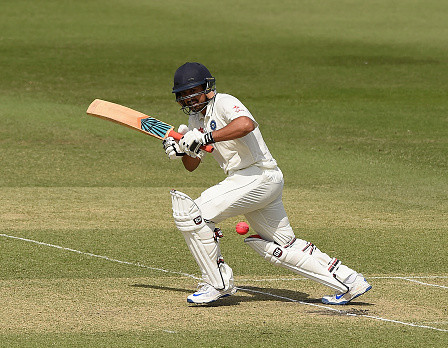
288/5. What does this score suggest?
On most pitches in India, it would be considered a below-par effort on the first day after winning the toss. But at the Wankhede, it’s a score that should make the batting side happy, for this isn’t a pitch where batting five sessions is a possibility.
The pitch at the Wankhede is made up of red soil (most pitches across the country are made of black soil with a high clay content) and therefore unlike other pitches, it offers more bounce and turn.
It also dries up quicker and crumbles faster than the rest. The first signs of what to expect from the pitch appeared in the eighth over of the day when a ball took a piece off the pitch while landing.
The only Mumbai players in this Test match at the Wankhede Stadium: Pathiv Patel and Jos Buttler - both for Mumbai Indians!#IndvEng
— Mohandas Menon (@mohanstatsman) December 8, 2016
There’s enough evidence to suggest that the first innings of this game, for both sides, is going to determine their respective fate. I feel that England are 112 runs away from safety and India have a window of 50 runs or an hour on the morning of the second day to stay competitive in this game.
Whichever team wins the first session on the second day is likely to be in the driver’s seat.
DIFFERENT PERSONNEL, DIFFERENT APPROACH
At the start of the tour, Alastair Cook found an able opening partner in Haseeb Hameed. Today, he not just found a worthy successor for himself but also a potential number three batsman for matches to come.
Keaton Jennings got a reprieve without opening his account and that turned out to be the only blemish in his dominating century on Test debut. He started as a skeptical driver, but grew in confidence as his innings progressed.
The way he handled the Indian spinners, employing three different varieties of the sweep shot (paddle sweep, proper sweep and the reverse sweep), reminded me of the great Andy Flower. He was quick to read the length and, more importantly, did not allow the pitch or the quality of the Indian spinners to alter his response.
The other refreshing aspect of England’s batting in the opening session was their intent to keep the scoreboard ticking.
ASHWIN, THE MASTER
Once again, Ravichandran Ashwin showcased why he’s a serial Man of the Match and Man of the Series award winner. Good players wait for chances to come their way to capitalise on them, but great players create those chances.
Ashwin’s display of his control over his craft was sensational to watch and just like the very top players, he made things happen. He made the ball swerve away from Joe Root and the ball landed an inch or two away from where England’s number three thought it would.
Drift ✅
— Aakash Chopra (@cricketaakash) December 8, 2016
Dip ✅
Turn ✅
Bounce ✅
Guile ✅
Ashwin has displayed all these in abundance on the first day. Spectacular stuff. 👏👏
Then, to dismiss Jennings, he made the ball dip and that foxed a well-set batsman, for he thought that it’d land a lot closer to the crease. After which, the extra bounce accounted for the wicket of Jonny Bairstow.
The yardsticks to judge a spinner are drift, dip, turn and bounce, and Ashwin displayed them in abundance on the first day. The Tamil Nadu spinner is this team’s most valuable player and his form is directly proportional to how the team fares.
INDIA’S CONCERNS
While India’s bowling has been the highlight of this series, their batting has relied mostly on Virat Kohli, Cheteshwar Pujara and the tail. Both Kohli and Pujara have been in great form throughout the series and have papered over the few cracks that have emerged time and again.

Murali Vijay started this series with a ton but has petered away a little since then. In the recent past, KL Rahul has missed more matches because of injuries than he’s played.
Ajinkya Rahane’s absence means Karun Nair getting another go. If three out of the top five batsmen aren’t in red-hot form, you are an innings away from things going kaput, and that would concern India and encourage England.
The average score across the four innings at Wankhede drops radically with each passing innings (in the last five Tests, the average score in the fourth innings is just 145) and since India have to bat last, it’s crucial to make the first innings count.
The beauty of playing at the Wankhede is that the match moves at a very brisk pace. While one must admit that England have their noses slightly ahead, you’ll have to rule out India at your own peril, for it takes only one brilliant session to change the complexion of this game.